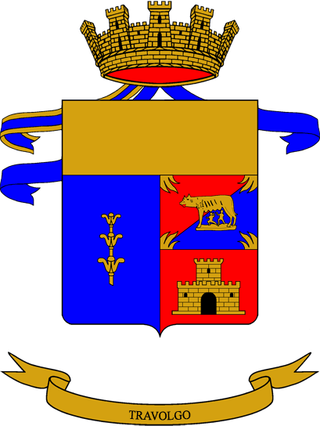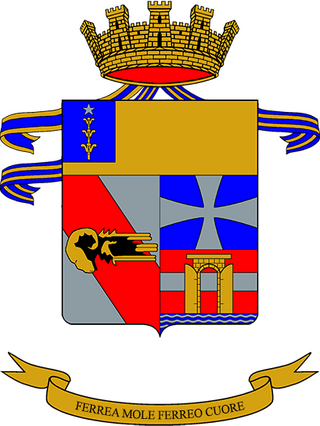
The L6/40 was a light tank used by the Italian army from 1940 through World War II. It was designed by Ansaldo as an export product, and was adopted by the Italian Army when officials learned of the design and expressed interest. It was the main tank employed by the Italian forces fighting on the Eastern Front alongside the L6/40-based Semovente 47/32 self-propelled gun. L6/40s were also used in the North African campaign.

The 132nd Armored Division "Ariete" was an armored division of the Royal Italian Army during World War II. It was formed in 1939 as the second armored division after the 131st Armored Division "Centauro". The division fought in the Western Desert Campaign until being destroyed during the Second Battle of El Alamein and declared lost due to wartime events on 8 December 1942.

The Cannone da 47/32 mod. 1935 was an Italian artillery piece that saw service during World War II. It was originally designed by Austrian firm Böhler, and produced in Italy under license. The Cannone da 47/32 was used both as an infantry gun and an anti-tank gun at which it was effective against light to medium armored tanks.

The Carro Armato M13/40 was an Italian World War II tank designed to replace the M11/39 in the Royal Italian Army at the start of World War II. It was the primary tank used by the Italians throughout the war. The design was influenced by the British Vickers 6-Ton and was based on the modified chassis of the earlier M11/39. Production of the M11/39 was cut short in order to get the M13/40 into production. The name refers to "M" for Medio (medium) according to the Italian tank weight standards at the time, 13 tonnes was the scheduled weight and 1940 the initial year of production.

The Carro Armato M11/39 was an Italian medium tank first produced prior to World War II. The M11/39 saw service in Africa and Italy (1939–1944). The official Italian designation was Carro Armato M11/39. The designation for the M11/39 is as follows: "M" for Medio ("medium"), followed by the weight in tonnes (11) and the year of adoption (1939).

The Carro Armato M15/42 was the last Italian medium tank produced during World War II. It was based on the earlier M13/40 and M14/41 medium tanks, and was built with the lessons from the North African Campaign in mind. The tank was meant to be a stopgap until the heavier P26/40 tank could be produced in numbers. It did not serve in North Africa, the theatre in which it was intended to operate, but served in Italy and in Yugoslavia with the German Wehrmacht.

The M 14/41 was a four-crew medium tank that served from 1941 in the Royal Italian Army. The official Italian designation was Carro Armato M 14/41. The tank was first employed in the North African Campaign where its shortcomings quickly became apparent.

The P 26/40 was an Italian World War II heavy tank. It was armed with a 75 mm gun and an 8 mm Breda machine gun, plus another optional machine gun in an anti-aircraft mount. Design had started in 1940 but very few had been built by the time Italy signed the armistice with the Allies in September 1943 and the few produced afterwards were used by the Germans.

Tanks were an important weapons system in World War II. Even though tanks in the inter-war years were the subject of widespread research, production was limited to relatively small numbers in a few countries. However, during World War II, most armies employed tanks, and production levels reached thousands each month. Tank usage, doctrine and production varied widely among the combatant nations. By war's end, a consensus was emerging regarding tank doctrine and design.

The L3/35 or Carro Veloce CV-35 was an Italian tankette that saw combat before and during World War II. Although designated a light tank by the Italian Army, its turretless configuration, weight and firepower make it closer to contemporary tankettes. It was the most numerous Italian armoured fighting vehicle and saw service almost everywhere the Italians fought in World War II but proved inadequate for modern warfare, having too thin armour and weak armament of only machine guns. It was cheaply produced but because of its light armaments and armour it was reserved to mostly colonial, policing, reconnaissance, and supply duties. However, given its low production costs, proved to be efficient in the Second Italo-Abyssinian War, Spanish Civil War and the Greco-Italian War where it provided reliable support to Italian infantry and disrupted enemy lines.

The Carro Veloce 33 (CV 33) or L3/33 was a tankette originally built in 1933 and used by the Italian Army before and during World War II. It was based on the imported British Carden Loyd tankette. Many CV 33s were retrofitted to meet the specifications of the CV 35 in 1935. In 1938, the CV 33 was renamed the "L3/33" while the CV 35 became the "L3/35s."

The Carro Armato M Celere Sahariano or M16/43 was a prototype medium tank developed by the Kingdom of Italy during World War II to match the speed and firepower of contemporary British cruiser tanks encountered by Italian forces during the Western Desert Campaign. The project was cancelled following the expulsion of Axis forces from North Africa in May 1943. Had it entered service, the tank's designation would likely have been M16/43: "M" for Medio, "16" representing the vehicle's weight in metric tons and "43" being the planned year of introduction.

Tanks have been employed by the military forces in Italy since their first use in World War I. They have had continued use in wars after and are still used through the modern day. The C1 Ariete is the current main battle tank of the Italian Army.

The 4th Tank Regiment is a tank regiment of the Italian Army based in Persano in Campania. Originally the regiment, like all Italian tank units, was part of the infantry, but since 1 June 1999 it is part of the cavalry. Operationally the regiment is assigned to the Bersaglieri Brigade "Garibaldi".

The 31st Tank Regiment is an inactive tank regiment of the Italian Army based in Lecce in Apulia. Originally the regiment, like all Italian tank units, was part of the infantry, but since 1 June 1999 it is part of the cavalry. Operationally the regiment was lastassigned to the Mechanized Brigade "Pinerolo". On 10 January 2020 the regiment was reformed as a reconnaissance unit and received the name, flag and traditions of the Regiment "Cavalleggeri di Lodi" (15th).

The 32nd Tank Regiment is a tank regiment of the Italian Army based in Tauriano in Friuli Venezia Giulia. Originally the regiment, like all Italian tank units, was part of the infantry, but since 1 June 1999 it is part of the cavalry. Operationally the regiment is assigned to the 132nd Armored Brigade "Ariete".
This page is based on this
Wikipedia article Text is available under the
CC BY-SA 4.0 license; additional terms may apply.
Images, videos and audio are available under their respective licenses.















